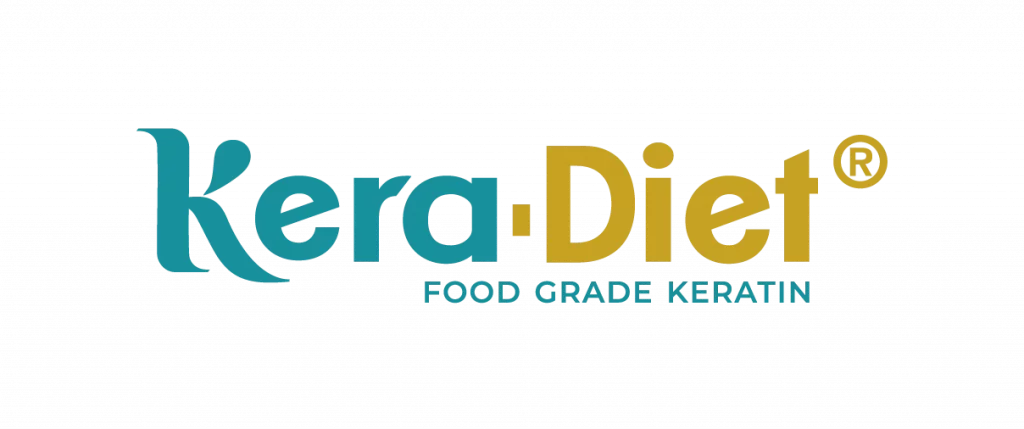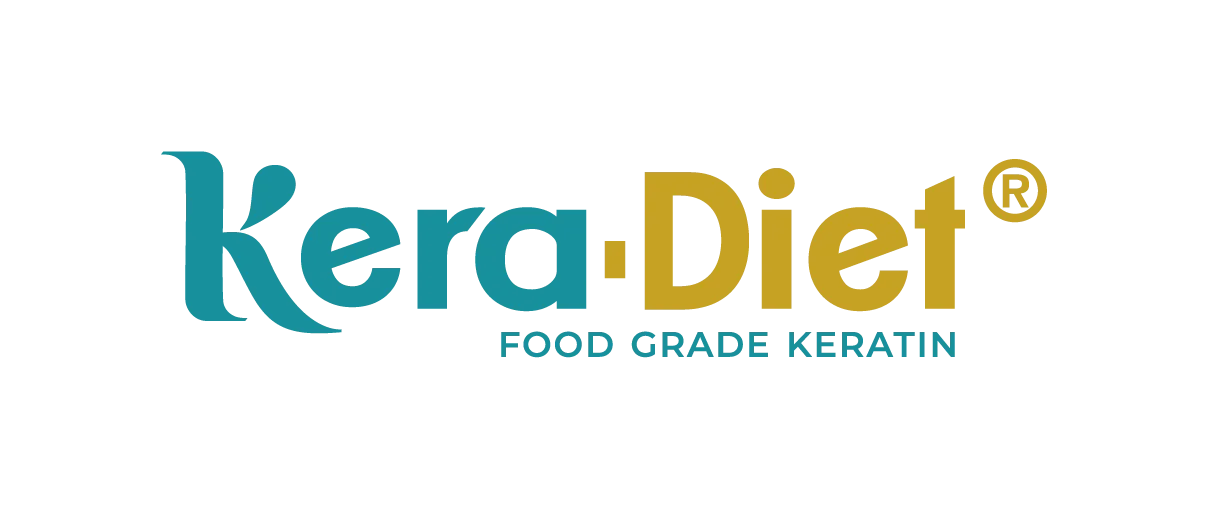Because we are driven by proven performance and significant results,
Kera-Diet® is the ingredient for your next formulations for Skin, Hair and Nails !



Food supplement applications
It is supported by the concept of “nutricosmetics” or “beauty in & out” which combines the use of topical care with care that acts from the inside of the body. As the epidermis draws a large amount of the circulating nutrients, it needs healthy food and active nutrients from food: the concept of “beauty from within” makes sense. Nutricosmetics is a contraction of the terms “nutrient” and “cosmetic” and this naming is perfectly adapted to food supplements designed for skin, hair and nails care. Even if food supplements can’t replace a healthy and diversified diet, they are able to compensate the insufficient consumption of certain nutrients that are important for healthy and beautiful skin, hair and nails.
The interest of keratin hydrolysate for hair and nails care was confirmed in 2017 by BCF Life Sciences, with a double-blind, placebo controlled clinical study conducted with 100 European women with a tendency to hair loss and brittle nails (Nobile et al., 2021).
The objective of this 90-day clinical study was to measure efficacy of a formulation containing extensive hydrolyzed food grade keratin (Kera-Diet®) – resulting in a high content of amino acids – supplemented with trace-elements and B vitamins compared to placebo and benchmark product.
Clinical results demonstrate the beneficial effects of Kera-Diet® formula on Skin, Hair and Nails beauty:
Kera-Diet®, an ingredient with proven performance for Skin, Hair and Nails with the 2023 clinical study
A first patent was granted in 2022 on Hair and Nails applications following the clinical results from 2017 study.
A second patent was filed in 2023 on Skin applications following the clinical results from 2023 study.
Both patents ensure a protection to BCF Life Sciences innovative process and are the reflect of its inventive and unique solutions.
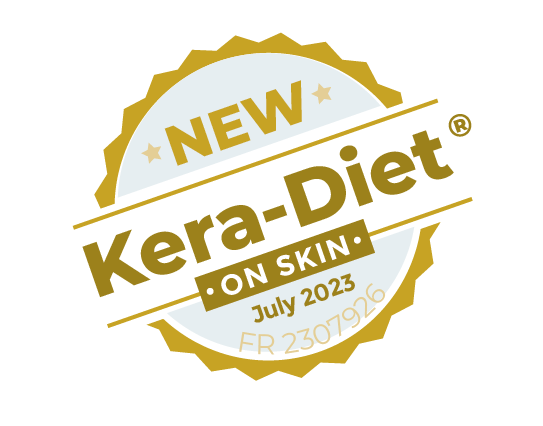
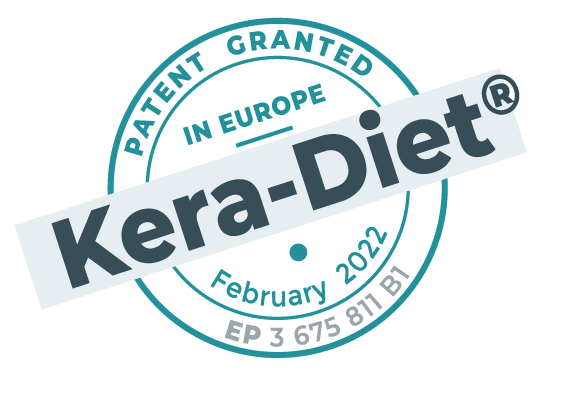
Latest results of our 2023 Clinical Study
A randomized multicenter placebo-controlled clinical study performed by BCF Life Sciences shows positive results with 500 mg daily intake of keratin hydrolysate Kera-Diet® without any other added ingredients. The study was carried out on 3 groups of 33 healthy women.
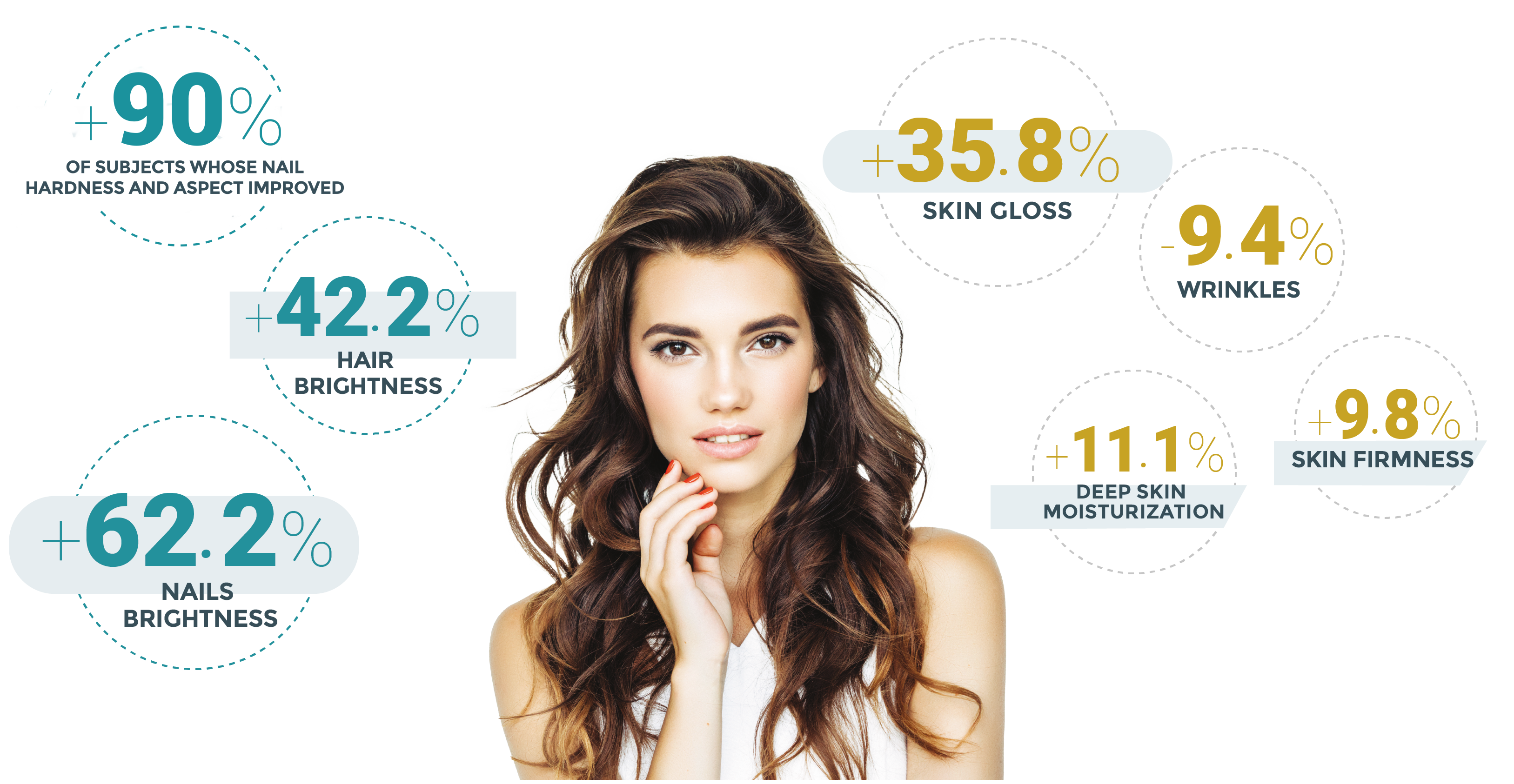
- Mode of action
There are additional results on the mode of action with in vitro studies about the effect of Kera-Diet® on Fibroblaste cells in oxydative stress conditions simulating skin aging. Results show that it limits stress and cellular aging in oxydative stress conditions.
Results as ROS production reduction, reduction of endoplasmic reticulum stress, reduction of cellular senescence activity (β-galactosidase, telomerase activity), decrease of apoptotic mechanisms (Caspase-3 activity)
Additional clinical results on the mode of action should be coming soon, contact us to get them!

Kera-Diet® :
easy to use
- Density : 0.5
- Creamy white color free-flowing powder
- Particule size : Dv100 < 800μm
Kera-Diet® is suitable for the following galenics :




Kera-Diet® : A unique profile
The traced origin Kera-Diet®, produced by BCF Life Sciences from feathers, a sustainable protein source, has been designed for human skin, hair and nails care use. It presents a stable and unique profile of 17 amino acids, more than 94% in free form, with a very low molecular weight (100% < 800 Daltons).
It is particularly rich in aspartic acid, serine, glutamic acid, glycine, leucine, arginine, proline and cystine, all of them on L-form.
What is keratin used for ?
Keratin is a fibrous and rigid protein that forms the structural basis of various tissues in animals, including skin, hair, and nails. It’s the most abundant « biomaterial », produced by animals after collagen.
In hair, Keratin is a filament-forming protein, containing a high level of sulfur, contained in the amino acid L-Cystine, forming disulfide bounds which gives it a specific spatial structure and provide strength, durability and elasticity.
Among keratinous materials, one of the most abundant and sustainable in nature is the chicken feathers keratin.
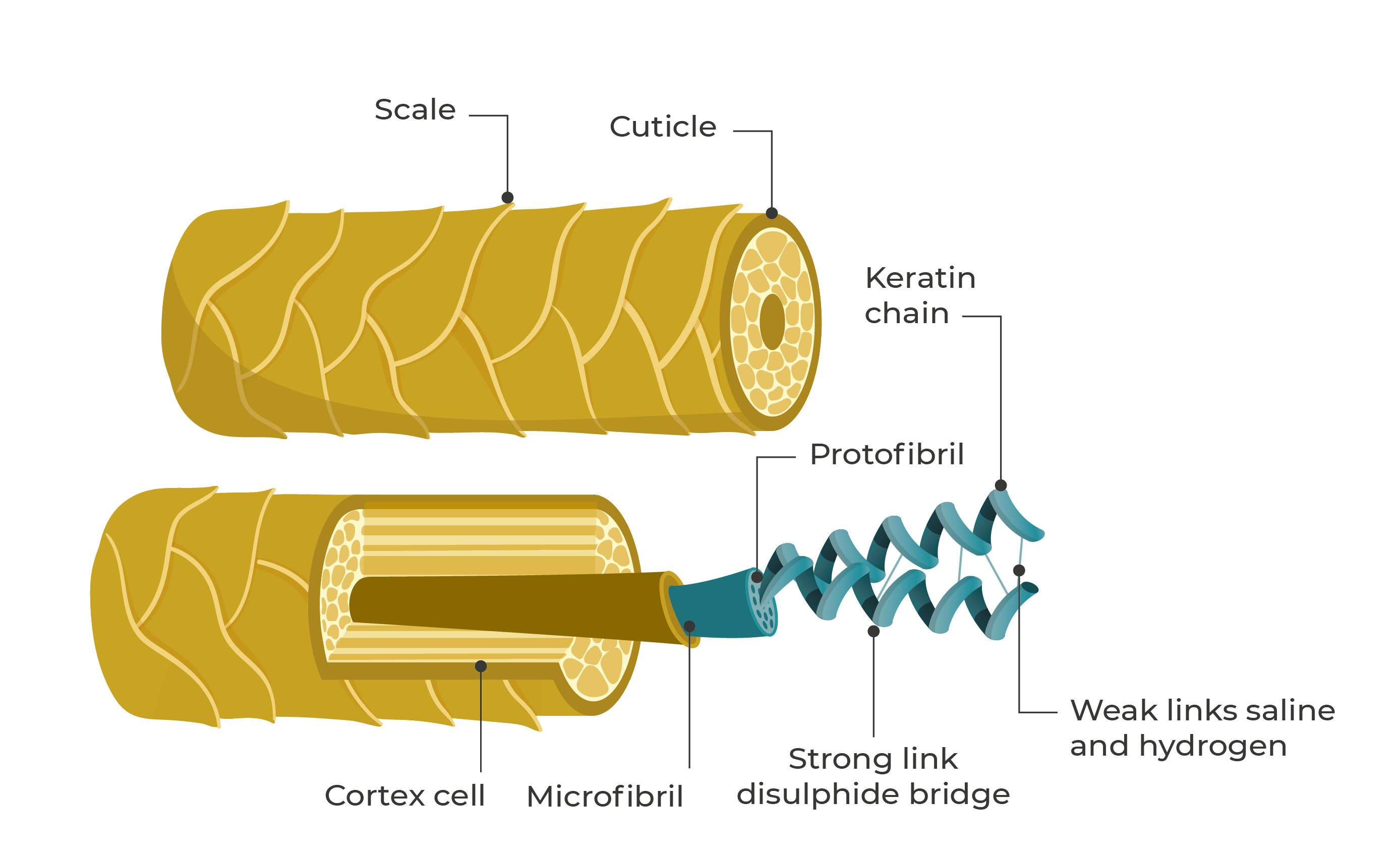
Microscopical view of fibers keratin in human hair with its filaments spatial structure
What is the difference between our Kera-Diet®
and other hydrolyzed keratins ?
Due to its molecular structure non-accessible to enzymes, native keratin is a protein that has a very low nutritive value.
That means that native keratin is very poorly digested and consequently not available for the living organism.
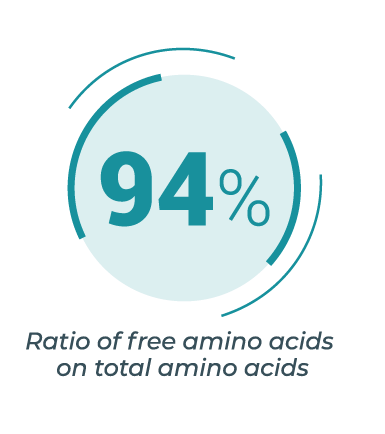
Considering the different processes of extraction on the native structure of keratin, two groups can be considered:
- The first group for which only intermolecular bonds are broken and where the extracted keratin molecules are approximately intact, more or less soluble in water, with high molecular weight peptides content.
- The second group where molecular structure of keratin is destroyed by breaking down peptide bonds, disulfide bridges and intermolecular hydrogen bonds resulting in low molecular weight peptides and single free amino acids content.
These methods can be chemical (sulfitolysis for the first group, acid or basic hydrolysis for the second group, for example), physical (high temperature steam cooking under pressure) or biological (microbial and enzymatic).
- The use of acid or for hydrolysis leads to highly hydrolyzed products very rich in free amino acids and peptides of low molecular weight
- Other methods are less effective and give final hydrolysates containing very few or no free amino acids and many medium (1000-10 000 Da) and high (>10 000 Da) molecular weight peptides.
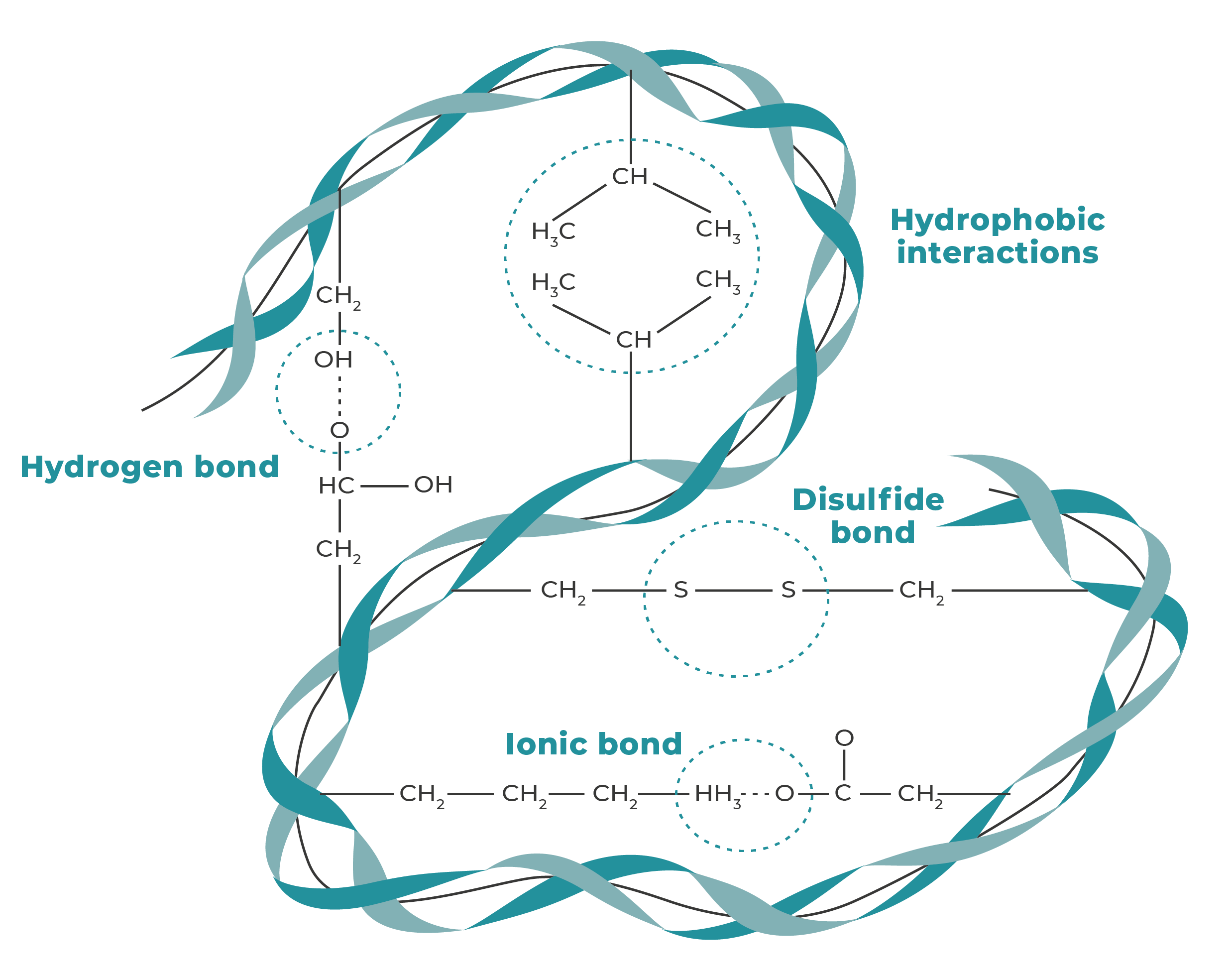
A view of the chemical bounds explaining the spatial structure of the keratin
(from Shavandi et al, 2017)
The advantages of an extensive hydrolysis
According to the state of art in the field of feather hydrolysis, acid hydrolysis is the most efficient to convert keratin fibers “quantitatively” into their individual and free amino acids and then obtain a keratin hydrolysate of very high nutritional value.
Acid hydrolysis is the most efficient method for breaking down keratin into free amino acids of L-form and small peptides, which can then be easily purified and isolated as a hydrolysate, with a high-water solubility.
Acid hydrolysis performed by BCF Life Sciences since 1986 follows a selective process which allows to maximize the quantity of free amino acids (83.5%) and minimize the size of the small remaining peptides (di, tri or tetra peptides).
In order to obtain keratin hydrolysate with a high free amino acid content, the process must be very well controlled and requires a very high level of know-how. For example, depending on the different hydrolysates produced by BCF Life Sciences, between 13 and 30 steps are involved in the process.
By carefully controlling the source of keratin, the conditions of the hydrolysis process and the purification steps, it is possible to obtain purified keratin hydrolysates with a high level of free amino acids (more than 94% of the total amino acids). These hydrolysates have a wide range of applications, including use as food supplements for skin, hair, and nails care.
A stable composition
Each process of keratin hydrolysis is specific to the producer: the one implemented for Kera-Diet®, with numerous steps and precise hydrolysis conditions (e.g., pH, temperature, time, acid concentration, etc.), leads to a stable hydrolysate with a well-defined L-form amino acids and composition.
This is an important advantage provided by acid hydrolysis, compared to basic hydrolysis, the latter denaturing the amino acids more strongly and resulting in racemization of most of the amino acids (D-form of amino acids, mainly non-compatible for animal use due to their high toxicity). This is one of the reasons that basic hydrolysis process is not used to produce amino acids for feed or food consumption.
A highly bioavailable keratin hydrolysate with a high nutritive value
The composition of hydrolysates obtained through this process depends completely on the hydrolysis parameters (time, temperature, type and concentration of acid) depending on the applications they are interested in.
An internal study has demonstrated that the amino acids digestibility of Kera-Diet® is 96,2 % in average, with a range of values between 84,4 to 99,2 % for individual amino acids in link with the high content in free amino acids of the hydrolysate. In this study, Kera-Diet® was compared to a benchmark product.
